[English] 日本語
 Yorodumi
Yorodumi- PDB-7mca: Structure of the S. cerevisiae origin recognition complex bound t... -
+ Open data
Open data
- Basic information
Basic information
| Entry | Database: PDB / ID: 7mca | |||||||||||||||
|---|---|---|---|---|---|---|---|---|---|---|---|---|---|---|---|---|
| Title | Structure of the S. cerevisiae origin recognition complex bound to the replication initiator Cdc6 and the ARS1 origin DNA. | |||||||||||||||
 Components Components |
| |||||||||||||||
 Keywords Keywords | REPLICATION / replication initiation | |||||||||||||||
| Function / homology |  Function and homology information Function and homology informationMCM complex loading / CDC6 association with the ORC:origin complex / Cul8-RING ubiquitin ligase complex / maintenance of rDNA / Assembly of the ORC complex at the origin of replication / nuclear origin of replication recognition complex / pre-replicative complex assembly involved in nuclear cell cycle DNA replication / Activation of the pre-replicative complex / nuclear pre-replicative complex / cyclin-dependent protein serine/threonine kinase inhibitor activity ...MCM complex loading / CDC6 association with the ORC:origin complex / Cul8-RING ubiquitin ligase complex / maintenance of rDNA / Assembly of the ORC complex at the origin of replication / nuclear origin of replication recognition complex / pre-replicative complex assembly involved in nuclear cell cycle DNA replication / Activation of the pre-replicative complex / nuclear pre-replicative complex / cyclin-dependent protein serine/threonine kinase inhibitor activity / DNA replication preinitiation complex / Activation of ATR in response to replication stress / nucleosome organization / mitotic DNA replication checkpoint signaling / regulation of DNA-templated DNA replication initiation / silent mating-type cassette heterochromatin formation / CDK-mediated phosphorylation and removal of Cdc6 / Orc1 removal from chromatin / regulation of DNA replication / DNA replication origin binding / DNA replication initiation / subtelomeric heterochromatin formation / nucleosome binding / G1/S transition of mitotic cell cycle / chromosome / chromosome, telomeric region / cell division / GTPase activity / chromatin binding / GTP binding / ATP hydrolysis activity / nucleoplasm / ATP binding / metal ion binding / nucleus / cytoplasm Similarity search - Function | |||||||||||||||
| Biological species |  | |||||||||||||||
| Method | ELECTRON MICROSCOPY / single particle reconstruction / cryo EM / Resolution: 3.6 Å | |||||||||||||||
 Authors Authors | Feng, X. / Li, H. | |||||||||||||||
| Funding support |  United States, 4items United States, 4items
| |||||||||||||||
 Citation Citation |  Journal: Nat Commun / Year: 2021 Journal: Nat Commun / Year: 2021Title: The structure of ORC-Cdc6 on an origin DNA reveals the mechanism of ORC activation by the replication initiator Cdc6. Authors: Xiang Feng / Yasunori Noguchi / Marta Barbon / Bruce Stillman / Christian Speck / Huilin Li /   Abstract: The Origin Recognition Complex (ORC) binds to sites in chromosomes to specify the location of origins of DNA replication. The S. cerevisiae ORC binds to specific DNA sequences throughout the cell ...The Origin Recognition Complex (ORC) binds to sites in chromosomes to specify the location of origins of DNA replication. The S. cerevisiae ORC binds to specific DNA sequences throughout the cell cycle but becomes active only when it binds to the replication initiator Cdc6. It has been unclear at the molecular level how Cdc6 activates ORC, converting it to an active recruiter of the Mcm2-7 hexamer, the core of the replicative helicase. Here we report the cryo-EM structure at 3.3 Å resolution of the yeast ORC-Cdc6 bound to an 85-bp ARS1 origin DNA. The structure reveals that Cdc6 contributes to origin DNA recognition via its winged helix domain (WHD) and its initiator-specific motif. Cdc6 binding rearranges a short α-helix in the Orc1 AAA+ domain and the Orc2 WHD, leading to the activation of the Cdc6 ATPase and the formation of the three sites for the recruitment of Mcm2-7, none of which are present in ORC alone. The results illuminate the molecular mechanism of a critical biochemical step in the licensing of eukaryotic replication origins. | |||||||||||||||
| History |
|
- Structure visualization
Structure visualization
| Movie |
 Movie viewer Movie viewer |
|---|---|
| Structure viewer | Molecule:  Molmil Molmil Jmol/JSmol Jmol/JSmol |
- Downloads & links
Downloads & links
- Download
Download
| PDBx/mmCIF format |  7mca.cif.gz 7mca.cif.gz | 585.1 KB | Display |  PDBx/mmCIF format PDBx/mmCIF format |
|---|---|---|---|---|
| PDB format |  pdb7mca.ent.gz pdb7mca.ent.gz | 450.7 KB | Display |  PDB format PDB format |
| PDBx/mmJSON format |  7mca.json.gz 7mca.json.gz | Tree view |  PDBx/mmJSON format PDBx/mmJSON format | |
| Others |  Other downloads Other downloads |
-Validation report
| Arichive directory |  https://data.pdbj.org/pub/pdb/validation_reports/mc/7mca https://data.pdbj.org/pub/pdb/validation_reports/mc/7mca ftp://data.pdbj.org/pub/pdb/validation_reports/mc/7mca ftp://data.pdbj.org/pub/pdb/validation_reports/mc/7mca | HTTPS FTP |
|---|
-Related structure data
| Related structure data |  23755MC  23818MC M: map data used to model this data C: citing same article ( |
|---|---|
| Similar structure data |
- Links
Links
- Assembly
Assembly
| Deposited unit | 
|
|---|---|
| 1 |
|
- Components
Components
-Origin recognition complex subunit ... , 6 types, 6 molecules ABCDEF
| #1: Protein | Mass: 104546.164 Da / Num. of mol.: 1 Source method: isolated from a genetically manipulated source Source: (gene. exp.)  Gene: ORC1 / Production host:  unidentified baculovirus / References: UniProt: P54784 unidentified baculovirus / References: UniProt: P54784 |
|---|---|
| #2: Protein | Mass: 71342.180 Da / Num. of mol.: 1 Source method: isolated from a genetically manipulated source Source: (gene. exp.)  Gene: ORC2 / Production host:  unidentified baculovirus / References: UniProt: P32833 unidentified baculovirus / References: UniProt: P32833 |
| #3: Protein | Mass: 72161.766 Da / Num. of mol.: 1 Source method: isolated from a genetically manipulated source Source: (gene. exp.)  Gene: ORC / Production host:  unidentified baculovirus / References: UniProt: P54790 unidentified baculovirus / References: UniProt: P54790 |
| #4: Protein | Mass: 60772.152 Da / Num. of mol.: 1 Source method: isolated from a genetically manipulated source Source: (gene. exp.)  Gene: ORC4, YPR162C, P9325.5 / Production host:  unidentified baculovirus / References: UniProt: P54791 unidentified baculovirus / References: UniProt: P54791 |
| #5: Protein | Mass: 55347.168 Da / Num. of mol.: 1 Source method: isolated from a genetically manipulated source Source: (gene. exp.)  Gene: ORC5, YNL261W, N0834 / Production host:  unidentified baculovirus / References: UniProt: P50874 unidentified baculovirus / References: UniProt: P50874 |
| #6: Protein | Mass: 50369.531 Da / Num. of mol.: 1 Source method: isolated from a genetically manipulated source Source: (gene. exp.)  Gene: ORC6, AAP1, YHR118C / Production host:  unidentified baculovirus / References: UniProt: P38826 unidentified baculovirus / References: UniProt: P38826 |
-DNA chain , 2 types, 2 molecules GH
| #7: DNA chain | Mass: 26184.838 Da / Num. of mol.: 1 / Source method: obtained synthetically / Source: (synth.)  |
|---|---|
| #8: DNA chain | Mass: 26229.906 Da / Num. of mol.: 1 / Source method: obtained synthetically / Source: (synth.)  |
-Protein , 1 types, 1 molecules I
| #9: Protein | Mass: 58112.367 Da / Num. of mol.: 1 Source method: isolated from a genetically manipulated source Source: (gene. exp.)  Gene: CDC6, YJL194W, J0347 / Production host:  unidentified baculovirus / References: UniProt: P09119 unidentified baculovirus / References: UniProt: P09119 |
|---|
-Non-polymers , 2 types, 8 molecules 


| #10: Chemical | ChemComp-MG / #11: Chemical | ChemComp-AGS / |
|---|
-Details
| Has ligand of interest | Y |
|---|
-Experimental details
-Experiment
| Experiment | Method: ELECTRON MICROSCOPY |
|---|---|
| EM experiment | Aggregation state: PARTICLE / 3D reconstruction method: single particle reconstruction |
- Sample preparation
Sample preparation
| Component | Name: Complex of origin replication complex with Cdc6 and ARS1 origin DNA Type: COMPLEX / Entity ID: #1-#9 / Source: RECOMBINANT | ||||||||||||||||||||||||||||||
|---|---|---|---|---|---|---|---|---|---|---|---|---|---|---|---|---|---|---|---|---|---|---|---|---|---|---|---|---|---|---|---|
| Molecular weight | Value: 0.47 MDa / Experimental value: NO | ||||||||||||||||||||||||||||||
| Source (natural) | Organism:  | ||||||||||||||||||||||||||||||
| Source (recombinant) | Organism:  unidentified baculovirus / Cell: Hi-5 cell / Plasmid: pAcUW51 unidentified baculovirus / Cell: Hi-5 cell / Plasmid: pAcUW51 | ||||||||||||||||||||||||||||||
| Buffer solution | pH: 7.5 | ||||||||||||||||||||||||||||||
| Buffer component |
| ||||||||||||||||||||||||||||||
| Specimen | Embedding applied: NO / Shadowing applied: NO / Staining applied: NO / Vitrification applied: YES | ||||||||||||||||||||||||||||||
| Specimen support | Grid material: COPPER / Grid mesh size: 300 divisions/in. / Grid type: Quantifoil R1.2/1.3 | ||||||||||||||||||||||||||||||
| Vitrification | Cryogen name: ETHANE |
- Electron microscopy imaging
Electron microscopy imaging
| Experimental equipment |  Model: Titan Krios / Image courtesy: FEI Company |
|---|---|
| Microscopy | Model: FEI TITAN KRIOS |
| Electron gun | Electron source:  FIELD EMISSION GUN / Accelerating voltage: 300 kV / Illumination mode: FLOOD BEAM FIELD EMISSION GUN / Accelerating voltage: 300 kV / Illumination mode: FLOOD BEAM |
| Electron lens | Mode: BRIGHT FIELD |
| Image recording | Electron dose: 76 e/Å2 / Film or detector model: GATAN K3 (6k x 4k) |
- Processing
Processing
| Software | Name: PHENIX / Version: 1.14_3260: / Classification: refinement | ||||||||||||||||||||||||||||||||||||||||||||
|---|---|---|---|---|---|---|---|---|---|---|---|---|---|---|---|---|---|---|---|---|---|---|---|---|---|---|---|---|---|---|---|---|---|---|---|---|---|---|---|---|---|---|---|---|---|
| EM software |
| ||||||||||||||||||||||||||||||||||||||||||||
| CTF correction | Type: NONE | ||||||||||||||||||||||||||||||||||||||||||||
| Particle selection | Num. of particles selected: 177397 | ||||||||||||||||||||||||||||||||||||||||||||
| 3D reconstruction | Resolution: 3.6 Å / Resolution method: FSC 0.143 CUT-OFF / Num. of particles: 72000 / Num. of class averages: 1 / Symmetry type: POINT | ||||||||||||||||||||||||||||||||||||||||||||
| Atomic model building | B value: 118.5 / Protocol: OTHER / Space: REAL / Target criteria: correlation coefficient | ||||||||||||||||||||||||||||||||||||||||||||
| Atomic model building | PDB-ID: 5V8F Accession code: 5V8F / Source name: PDB / Type: experimental model |
 Movie
Movie Controller
Controller


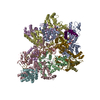
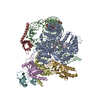


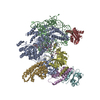
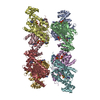
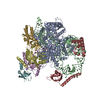
 PDBj
PDBj












































